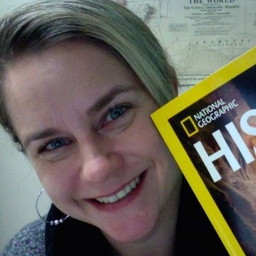
Amy Briggs
Executive Editor at National Geographic
Executive Editor, National Geographic HISTORY magazine; Co-host, Overheard @ National Geographic; Also watches too much television
Articles
-
Nov 20, 2024 |
nationalgeographic.com | Amy Briggs
Gladiators seem to be made for the cinema. Strong warriors armed with exotic weapons fighting one-on-one in the Colosseum as emperors and nobles look on. These clashes have become a staple of any story set in imperial Rome, contrasting the brute strength of these fighters and the pampered decadence of the elite. The full story of gladiators in the Roman Empire continues to expand as new discoveries come to light through archaeology.
-
Apr 16, 2024 |
nationalgeographic.com | Amy Briggs
People write down lots of things—from epic poems and sacred texts to tax decrees and shopping lists. But these things are of little use to anyone if they can’t be read. Broken tablets, fragile scrolls, or coded manuscripts have intrigued scholars for centuries. Many devoted countless hours to decoding past people's scribblings. Thanks to them, humanity has compiled a massive knowledge base of writing systems and languages. But some texts still elude our understanding.
-
Mar 23, 2024 |
canberratimes.com.au | Amy Briggs
Space debris is a huge problem. The first piece of space debris came from the launch of Sputnik in 1957. Since that day, many objects have joined Sputnik in orbit, with the potential to collide with other debris and working satellites. or signup to continue readingSee subscription optionsWhen objects collide in space, it creates more debris.
-
Mar 23, 2024 |
illawarramercury.com.au | Amy Briggs
Space debris is a huge problem. The first piece of space debris came from the launch of Sputnik in 1957. Since that day, many objects have joined Sputnik in orbit, with the potential to collide with other debris and working satellites. or signup to continue readingSee subscription optionsWhen objects collide in space, it creates more debris.
-
Mar 23, 2024 |
newcastleherald.com.au | Amy Briggs
Space debris is a huge problem. The first piece of space debris came from the launch of Sputnik in 1957. Since that day, many objects have joined Sputnik in orbit, with the potential to collide with other debris and working satellites. or signup to continue readingSee subscription optionsWhen objects collide in space, it creates more debris.
Try JournoFinder For Free
Search and contact over 1M+ journalist profiles, browse 100M+ articles, and unlock powerful PR tools.
Start Your 7-Day Free Trial →X (formerly Twitter)
- Followers
- 702
- Tweets
- 608
- DMs Open
- No